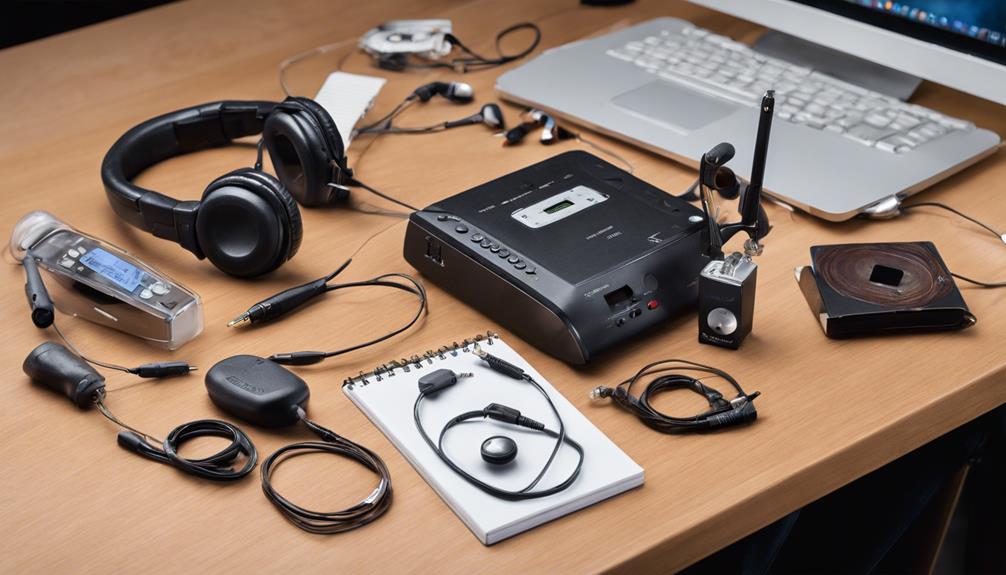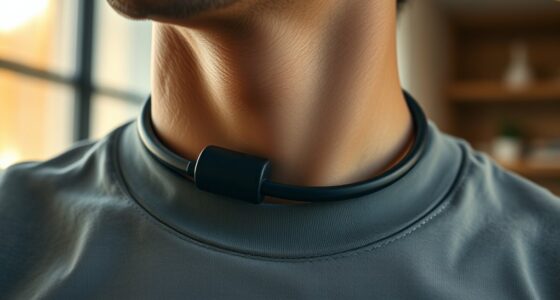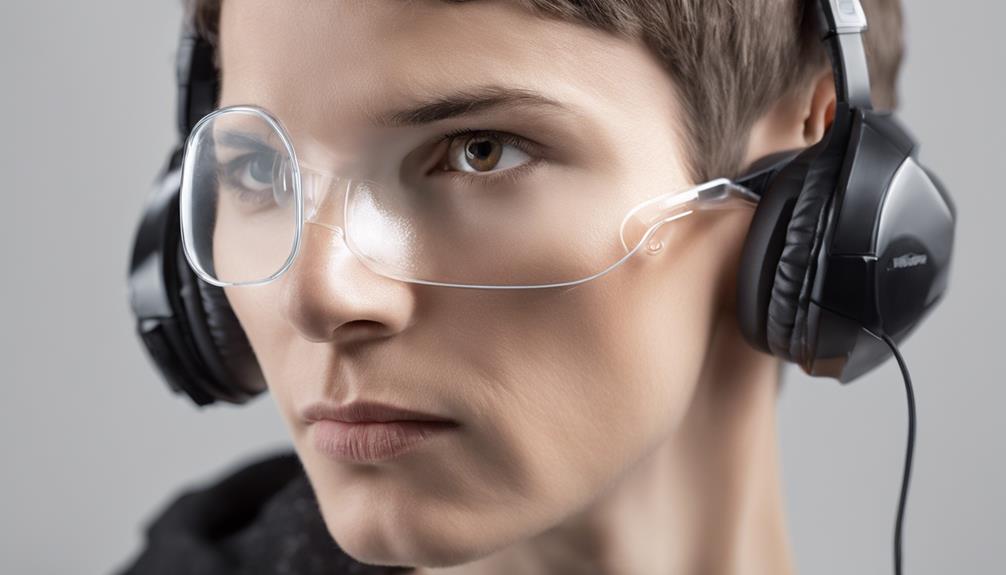Exploring the realm of assistive listening systems for students reveals that approximately 15% of school-aged children experience varying levels of hearing impairment.
Unveiling the world of technologies designed to bridge this gap, our guide meticulously dissects the top assistive listening systems available, offering insights into their functionalities and benefits.
Discover how these innovative devices are revolutionizing the educational landscape for students with hearing impairments, paving the way for enhanced learning experiences and improved academic outcomes.
Key Takeaways
- Wireless systems with Bluetooth and FM technology enhance accessibility and connectivity.
- Advanced sound quality features improve speech clarity and reduce background noise for students.
- FM systems offer high-quality audio transmission, ideal for educational settings.
- Induction loop systems like Williams Sound enhance speech intelligibility in various metal-structured spaces.
Wireless Systems
Wireless assistive listening systems utilize advanced technologies such as FM, Wi-Fi, Bluetooth, and Infrared to transmit audio wirelessly, enhancing accessibility and mobility for students with hearing impairments.
Infrared systems, a type of wireless system, operate by using infrared light to carry sound to a receiver worn by the student. They're particularly useful in environments where radio frequency interference could be an issue, such as in classrooms with a lot of electronic devices.
FM systems, another form of wireless technology, transmit sound via radio waves, providing a reliable connection between the speaker's microphone and the student's receiver.
Additionally, Bluetooth technology allows seamless connectivity between the student's hearing aids or cochlear implants and the audio source. These wireless systems offer students with hearing impairments the freedom to move around without being constrained by cables, fostering a more inclusive and engaging learning environment.
Personal Amplifiers

Moving from wireless systems to a more personal solution for students with hearing impairments, personal amplifiers are portable devices designed to enhance sound for individuals facing hearing difficulties.
These small, portable devices are ideal for use in classrooms, helping students with hearing difficulties to better understand the teacher's voice. Personal amplifiers excel in small group settings or one-on-one conversations, providing clear and amplified sound directly to the user.
Easy to operate and discreet to wear, these devices offer a practical solution for students with mild to moderate hearing loss. By using personal amplifiers, students can actively participate in class discussions, group activities, and conversations without missing important information.
The versatility and effectiveness of personal amplifiers make them a valuable tool for students seeking to overcome hearing challenges in educational settings.
FM Systems
FM systems offer a valuable solution for students with hearing impairments, utilizing FM radio waves to deliver high-quality audio.
These systems are particularly effective in educational settings, helping students discern the teacher's voice amidst surrounding noise.
Setting up FM systems involves using a microphone for the speaker and a receiver for the student, ensuring direct sound transmission.
Benefits of FM Systems
How do FM systems significantly enhance speech intelligibility for students with hearing loss in educational environments?
FM systems play a crucial role in overcoming challenges related to background noise by providing a signal-to-noise ratio of 15-20 dB. This enhancement allows students to hear teachers clearly, as the systems wirelessly transmit the instructor's voice directly to their hearing aids or receivers.
By ensuring that students can focus on the speaker without distractions, FM systems improve listening comprehension and academic performance. Additionally, these systems offer portability, ease of use, and flexibility, enabling students to move around while staying connected to the audio source.
Types of FM Systems
Having explored the benefits of FM systems in enhancing speech intelligibility for students with hearing loss in educational settings, the discussion now shifts to examining the various types of FM systems available to cater to different needs and preferences.
FM systems utilize FM radio waves for audio transmission, ensuring improved sound quality for individuals with hearing impairments. These systems are widely used in educational settings such as classrooms and lecture halls to facilitate clear communication.
Different types of FM systems offer features like reducing background noise, enhancing speech intelligibility, and providing portability for students to move around while staying connected to the audio source. Additionally, FM systems are compatible with hearing aids, making them accessible and beneficial tools for students with hearing loss.
Setting Up FM Systems
Setting up the FM systems in educational environments requires precise placement and configuration to ensure optimal audio transmission and clarity for students with hearing loss.
FM systems utilize FM radio waves to deliver clear sound quality in classrooms, aiding students in hearing teachers and peers effectively. By minimizing background noise, these systems enhance students' ability to focus on the speaker's voice, improving speech intelligibility.
The portable nature of FM systems allows for easy installation and adaptability in various classroom settings. This setup not only benefits students by providing a better listening experience but also contributes to their comprehension and learning outcomes.
Proper installation and calibration of FM systems are essential to maximize their effectiveness in educational settings.
Infrared Systems

Infrared systems utilize light-based technology to wirelessly transmit audio signals in environments that allow for direct line of sight communication. These systems are particularly suited for smaller spaces where clear transmission paths can be maintained. While offering excellent audio quality, they aren't recommended for large group settings due to potential interference issues.
Infrared systems require a direct line of sight between the transmitter and receiver to function optimally, making them ideal for spaces like courtrooms or entertainment venues where privacy and limited interference are crucial. The technology behind infrared systems ensures that the audio signal remains contained within the designated area, enhancing confidentiality. Users benefit from the clear sound reproduction facilitated by these systems, especially in situations where background noise can be a challenge.
Understanding the limitations and advantages of infrared systems is key to effectively implementing them in environments that align with their operational requirements.
Loop Systems
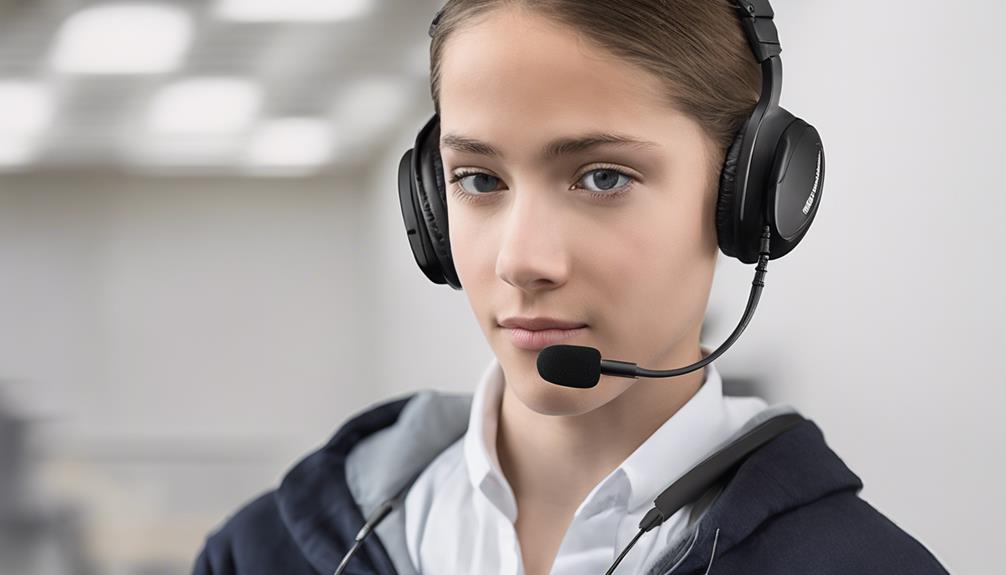
Loop systems, employing electromagnetic transmission, enable the direct delivery of sound to hearing aids equipped with telecoils, commonly assisting students with hearing loss in educational settings such as classrooms, lecture halls, and theaters. These systems are designed to enhance speech clarity and reduce background noise, providing a more conducive learning environment for students.
Here are some key features of loop systems:
- Direct Sound Delivery: Loop systems use electromagnetic fields to transmit sound signals directly to hearing aids with telecoils, bypassing ambient noise for clearer audio reception.
- Improved Speech Clarity: By delivering sound directly to the hearing aid, loop systems enhance speech intelligibility, making it easier for students to follow conversations and lectures.
- Background Noise Reduction: Loop systems help minimize background noise interference, allowing students to focus better on the speaker's voice and key information.
- Optimal for Educational Settings: Loop systems are particularly beneficial in educational settings where clear communication is crucial for academic success, providing an inclusive learning experience for students with hearing impairments.
Bluetooth Devices
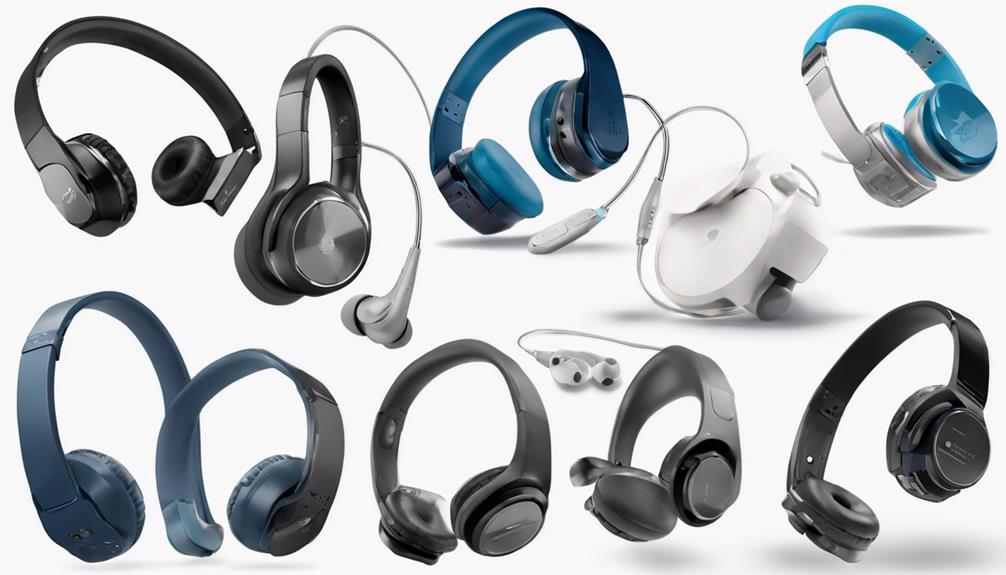
Bluetooth ALDs provide students with wireless connectivity options, allowing seamless audio streaming to their devices.
These devices offer compatibility with a range of gadgets such as smartphones, tablets, and computers.
Additionally, Bluetooth technology enhances sound quality features, enabling students to personalize their listening experience for optimal clarity.
Wireless Connectivity Options
Enhancing connectivity options for students with hearing loss, wireless devices provide seamless audio transmission for clearer listening in educational settings. Bluetooth devices offer versatile wireless connectivity by connecting to smartphones, laptops, and tablets, enabling direct sound input. This allows students to pair their assistive listening devices with multiple devices, promoting ease of use.
Through Bluetooth technology, students can conveniently adjust volume levels and settings, enhancing their learning experience. Bluetooth connectivity in assistive listening devices plays a vital role in fostering independence and inclusivity in classroom environments, breaking down communication barriers effectively.
Compatibility With Devices
In exploring the compatibility of Bluetooth assistive listening devices with various technologies, students benefit from seamless audio streaming across a wide array of compatible devices. These devices provide wireless connectivity, enabling easy audio streaming from smartphones, tablets, computers, and other Bluetooth-enabled gadgets.
The flexibility offered by these devices allows students to effortlessly switch between different devices, enhancing their overall user experience. Bluetooth technology ensures a stable connection, guaranteeing high-quality sound transmission for an optimal listening experience.
Sound Quality Features
Students benefit from advanced sound quality features in Bluetooth devices, ensuring optimal audio clarity and minimal interference during educational activities.
Bluetooth devices offer wireless connectivity, allowing students freedom of movement in the classroom.
The high-quality sound transmission directly to students' hearing aids or headphones enhances the overall listening experience.
Bluetooth technology effectively reduces background noise, providing students with hearing loss a clearer audio integration.
These devices are versatile and can be effortlessly paired with smartphones, tablets, or laptops, making them a popular choice for students seeking improved sound quality in educational settings.
Soundfield Systems

Utilizing strategically positioned microphones, soundfield systems evenly distribute sound throughout a classroom to enhance speech intelligibility and reduce background noise for students with hearing impairments. These systems play a crucial role in creating an inclusive learning environment by ensuring that all students, regardless of their hearing abilities, have equal access to educational content. By amplifying the teacher's voice and minimizing distractions caused by environmental noises, soundfield systems improve focus, comprehension, and overall learning outcomes for students.
Implementing soundfield systems is particularly beneficial in large classrooms or noisy settings where hearing can be a challenge. Not only do these systems benefit students with hearing impairments, but they also enhance the educational experience for the entire class. The technology behind soundfield systems aligns with the principles of inclusive education, promoting equal opportunities for all learners to thrive academically. In educational settings, the integration of soundfield systems reflects a commitment to providing a supportive and accessible learning environment for students.
Classroom Audio Distribution

Classroom audio distribution encompasses various systems like Sound Amplification Systems, Personal FM Systems, and Hearing Loop Technology.
These technologies play a crucial role in delivering clear sound directly to students with hearing impairments.
Sound Amplification Systems
Enhancing the teacher's voice clarity and reducing background noise, sound amplification systems, also known as Classroom Audio Distribution systems, play a crucial role in creating inclusive and accessible educational environments. These systems are essential for students with hearing loss, attention issues, or language barriers.
Here are some key points about sound amplification systems:
- Enhance speech intelligibility for all students.
- Reduce teacher vocal strain and improve classroom management.
- Increase student engagement, participation, and academic performance.
- Provide cost-effective solutions for creating inclusive learning environments.
Sound amplification systems offer significant benefits by ensuring that every student can clearly hear the teacher's instructions, fostering a conducive learning atmosphere for all.
Personal FM Systems
When implementing Personal FM Systems in educational settings, instructors can ensure clear sound transmission directly to students with hearing impairments, boosting their engagement and academic performance.
Personal FM systems, such as the Phonak Roger Pen, offer a signal-to-noise ratio of up to 20 dB, effectively reducing background noise and allowing students to hear teachers with clarity. These systems are compatible with hearing aids and cochlear implants, providing improved speech understanding for students with auditory processing disorders.
The Phonak Roger Pen's range of up to 33 feet enables students to move freely in the classroom while staying connected to the audio.
Hearing Loop Technology
Utilizing magnetic fields, hearing loop technology directly transmits sound to compatible hearing aids, offering personalized audio distribution for students with hearing loss. In classroom settings, this induction loop system enhances communication by creating a magnetic field that eliminates background noise and delivers clear, customized sound to the user's hearing device. Ideal for students wearing telecoil-equipped hearing aids, the technology ensures a seamless listening experience, allowing individuals with hearing difficulties to fully participate in classroom activities without missing crucial information.
Hearing loop technology, also known as an induction loop system, uses magnetic fields to transmit sound directly to compatible hearing aids. This technology is commonly used in classroom settings to enhance audio distribution and improve communication for students with hearing loss. It eliminates background noise and provides clear, personalized sound directly to the user's hearing device. Hearing loop systems are ideal for students wearing telecoil-equipped hearing aids, offering a seamless listening experience.
Remote Microphone Systems

Remote microphone systems revolutionize auditory learning experiences for students by delivering clear, direct audio transmission from speakers to their ears, minimizing background noise and enhancing speech clarity. These systems offer a significant advantage in educational settings by ensuring that students hear the speaker's voice clearly without interference. By reducing background noise, remote microphone systems contribute to improved speech intelligibility, which is essential for students' academic performance. Additionally, these systems can be seamlessly integrated with hearing aids and cochlear implants, providing personalized amplification tailored to each student's specific hearing needs. This customization enhances the overall effectiveness of the system for individual users. The table below highlights key features of remote microphone systems:
| Features | Description |
|---|---|
| Direct Audio Transmission | Ensures clear sound delivery directly from the speaker to the student's ears |
| Background Noise Reduction | Minimizes distractions and enhances focus on the speaker's voice |
| Speech Clarity | Improves the intelligibility of speech, leading to better comprehension |
Induction Loop Systems
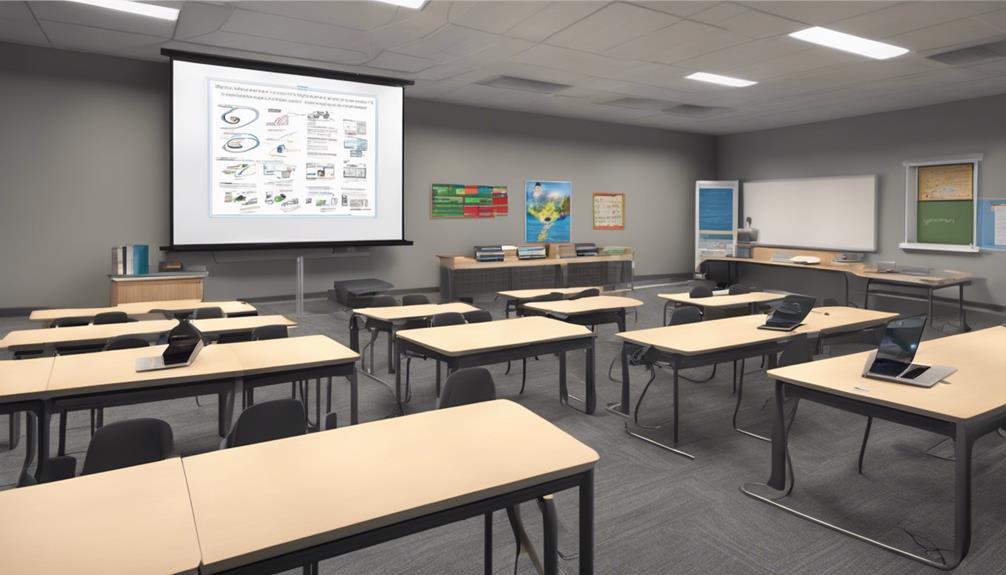
Induction loop systems, leveraging magnetic fields to transmit audio directly to telecoil-equipped hearing aids, provide a discreet and effective solution for enhancing sound quality in various public venues and spaces with metal structures. These systems are a staple in the realm of Assistive Listening Systems (ALSs), offering significant benefits for individuals with hearing aids and cochlear implants.
Here are key points about Induction Loop Systems:
- Ideal for Metal Structures: Induction loops excel in spaces with metal structures, ensuring clear communication for those with hearing impairments.
- Common Venues: These systems are frequently found in theaters, churches, conference rooms, and other public spaces to facilitate improved sound quality for users.
- Speech Intelligibility: Users experience enhanced speech intelligibility and reduced background noise, creating a more comfortable listening environment.
- Williams Sound Technology: Companies like Williams Sound are known for producing high-quality induction loop systems that leverage the power of magnetic fields for effective audio transmission.
Frequently Asked Questions
What Is the Most Commonly Used Assistive Listening Device?
The most commonly used assistive listening device is the FM system, transmitting audio via FM radio waves for clear sound reception. It helps students with hearing loss hear the teacher's voice directly, reducing background noise and improving comprehension.
These discreet, portable systems allow students to move around the classroom while staying connected. Beneficial for students with mild to profound hearing loss, FM systems enhance auditory access in educational settings, improving academic performance and student engagement.
What Are the Assistive Devices for Hearing Impaired Students?
We use assistive devices like FM systems, induction loops, and personal amplifiers to help hearing impaired students in educational settings. These tools enhance sound quality, reduce background noise, and ensure students hear clearly.
FM systems transmit audio directly to hearing aids or headphones, induction loops connect to telecoil-equipped aids via magnetic fields, and personal amplifiers amplify sound for better engagement.
These devices are crucial for students to follow lessons and participate effectively.
What Are the Alternatives to the FM System?
We've explored a range of alternatives to the FM system, such as infrared, induction loop, Bluetooth, personal amplification, and hearing loop systems. Each of these options offers unique features to cater to diverse listening needs.
From light-based transmission with infrared systems to electromagnetic audio transmission in induction loop systems, these technologies provide effective solutions for individuals seeking alternatives to traditional FM systems.
What Is the Difference Between an Assistive Listening Device and a Hearing Aid?
When comparing an assistive listening device (ALD) to a hearing aid, the key distinction lies in their intended purpose and design. ALDs are separate devices that amplify and clarify sound, aiding individuals with hearing loss by improving clarity and reducing background noise.
In contrast, hearing aids are custom devices specifically tailored to address an individual's unique hearing loss levels and frequencies through amplification and sound processing. Both serve to enhance hearing abilities, yet each fulfills distinct needs.
Conclusion
In conclusion, when it comes to assistive listening devices for students, it's crucial to consider the various options available to ensure optimal sound quality and communication in educational settings.
By exploring wireless systems, personal amplifiers, FM systems, infrared systems, loop systems, soundfield systems, classroom audio distribution, remote microphone systems, and induction loop systems, educators can provide a conducive learning environment for students with hearing impairments.
Let's amplify learning opportunities with the right assistive listening devices.

